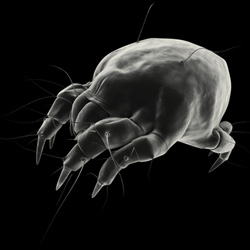Mites and mite biology
Mites belong to the class of Acaridae and a significant number of them cause problems in stored foods, such as flour, cheese, pollen and dried fruits. Some of them have evolved to digest protein-rich skin scales (house dust mites) present in every home. Others take blood from warm-blooded animals (i.e. bird mites) and they readily bite man if their favorite species (birds) are absent, and conditions are right (i.e. high humidity greater than 60%, and warm conditions).
Mites are 8 legged Arthropods, following an incomplete metamorphosis from a juvenile 6 legged stage, and go through a number of skin moults when growing. Mites have the ability to go into dormancy (hypopus stage) when conditions are less favourable, which can pose problems for effective control using conventional insecticides. In addition mites are naturally more resistant to common household insecticides than insects and professional acaricides are the preferred option when the infestation is substantial.
Occasionally bites occur with no obvious pests. In these circumstances the origin of the bites might be from hungry bird mites from abandoned birds nests (Dermanyssus gallinae). Conditions which are favourable to all mites and encourage their dispersal from a confined locations (i.e. birds nests) are a high level of relative humidity.
House dust mite

Scanning Electron Micrograph of a House dust mite (Dermatophagoides pteronyssinus) X250 magnification
House dust mites are small >0.5mm and their numbers increase from early summer and decline during winter. An increasing number of people are allergic to house dust mites, their exoskeletal fragments and/or their droppings. It is almost impossible to eliminate house dust mites from the home, but extreme high levels of hygiene can reduce mite numbers significantly. Reducing the humidity using air-conditioning / de-humidifiers to reduce moisture is a proven strategy to reduce mite populations even further.
